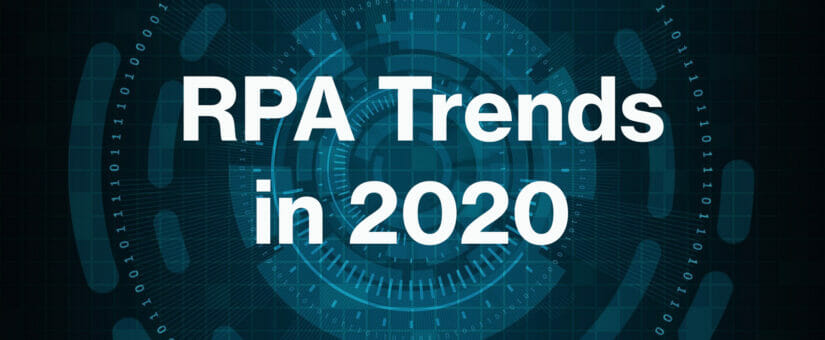
Top Five RPA Trends in 2020
- Posted by Adham Jan
- On April 27, 2020
Robotic Process Automation (RPA) is a hot topic in IT as businesses start looking at ways of freeing up their employees for more high-valued work. Closely related to Artificial Intelligence (AI) and automation, RPA is growing in recent years and is predicted to grow rapidly in 2020. But what are RPA top five trends in 2020?
RPA Trends
Although the future is hazy, many experts foresee a bright future for RPA, As most companies use RPA to try out AI in their businesses. Forrester predicts that the RPA software market will hit $2.9 billion by 2021—up from just $250 million in 2016. The projected growth along with the possibility of a recession assures that RPA has a future. Businesses seek to make their companies do more without hiring more people to do tasks that are better suited for automation.
Five RPA trends for 2020
1. RPA will become a $1.3 billion dollar industry in 2020 , with a compound annual growth rate of 41%.
According to Gartner, RPA will become a $1.3 billion dollar industry in 2020 , with a compound annual growth rate of 41%. That number will more than double in 2021. More organizations will adopt RPA for various tasks such as sales, simple customer contact, and data entry. Furthermore, over 70% of business leaders have stated that they plan to invest more in the deployment and development of RPA, according to the Institute for RPA and AI Survey.
2. RPA will be adopted by institutions such as banking and finance.
As banks and other financial institutions realize the advantage to using RPA bots to ensure accuracy and compliance. Banks will quickly adopt RPA to free up their employees for more meaningful tasks, such as meeting with customers and potential clients. Learn more about RPA use cases in banking
3. RPA will also transform job roles, as enterprises achieve new levels of efficiency and productivity.
Robotic automation will save workers’ jobs should there be a global recession. Although counter-intuitive, adopting RPA for tasks that would normally cost millions of dollars in employee hours, saves a company money. It allows the employees to work toward finding new business, customers, and clients. Robotic automation is meant to only eliminate the need to allocate employees for manual repetitive tasks. In order to allocate human resources to higher priority tasks that involve real decisions that an RPA robot wouldn’t be able to make.
4. More customers will interact with RPA and won’t even know that they’re not dealing with a live person.
AI is becoming smarter every year and RPA is no exception. Soon, interacting with RPA will be seamless and appear to be just like communicating with a live human being.
5. Different RPA will be integrated to perform the desired tasks
Robotic Process Automation can be written in code that can be used and combined in different ways to achieve the desired result. Different RPA will be integrated to perform the desired tasks. It will make it easier than ever to get off the shelf solutions to your business needs.
What is RPA?
Robotic Process Automation (RPA) is software designed to automate certain repetitive and tedious tasks. RPA will free up employees for more complex work that requires human intervention. IT is simple as an automated message stating that you’ve received an email from someone and thanking them. RPA can become more complex, such as data entry and customer service.
Do you need RPA?
Robotic Process Automation is especially good for redundant tasks, as well as integrating RPA with Artificial Intelligence (AI). It can save businesses money and enhance productivity, because employees no longer need to do the repetitious tasks. Companies no longer have to hire extra people to perform tedious work. It’s a win-win for both employees and businesses because it enables businesses to use their employees more effectively and allows them to save money.
A study by PWC showed that companies expect to be ROI positive in fewer than 14 months of deploying their RPA projects, making RPA a solid business investment.
Learn more about RPA Solution
Tasks RPA Can Perform
RPA can perform a variety of tasks that can help free up overworked employees to work on growing the business instead of performing time-consuming, redundant tasks.
Examples of work performed by RPA include:
- Reprice home loans with a mortgage company.
- Refund purchases such as airline tickets automatically.
- Obtain refill prescription orders from patients who need recurring medications.
- Handle HR work such as payroll, on-boarding, and benefits enrollment.
- Perform routine checks on servers and software to ensure everything is running smoothly.
- Handle routine accounting tasks such as Record to Report cycles and Procure to Pay.
There are numerous use cases for RPA across industries, learn more why should you consider RPA.



